In June 2018, the idea that Bordeaux had a very good vintage on its hands was laughable. The first half of the year had seen incessant rain in the region. Mildew was rife and vignerons were fighting it all day long, including at weekends (if they could afford to). At Château Corbin, owner Anabelle Cruse cancelled her trip to Vinexpo Hong Kong to be on site to manage treatments. “We couldn’t afford any mistakes after losing nearly all of the 2017 vintage [to frost],” she said.
But then on 18th June, the weather turned, and barely another drop of rain fell until September. 2018 was a year of extremes for Bordeaux. “It started hellish, and finished in ecstasy,” said Sara Lecompte Cuvelier, Managing Director at Léoville-Poyferré. “It started a nightmare and finished a dream,” echoed Guillaume Pouthier, Director at Carmes Haut-Brion.
Against all odds, some truly extraordinary wines were made. “Technically, it’s the most accomplished wine we have made since I joined,” said Nicolas Glumineau, Managing Director of Pichon Comtesse since 2012. Adrien Bernard declared, “the 2018 [red] is the greatest wine my dad has made” – the Bernard family bought Domaine de Chevalier in 1983. But 2018 was not a great vintage across the board like 1982, 1989, or 2010. It wasn’t a vintage where you could make a great wine with your eyes closed. On the contrary, 2018 is a vintage where human choices really mattered, and at the top level, happily, these choices were usually the right ones.
 Happy with their 2018s: Guillaume Pouthier, Pierre-Olivier Clouet, and Nicolas Glumineau
Happy with their 2018s: Guillaume Pouthier, Pierre-Olivier Clouet, and Nicolas Glumineau
Concentration in the 2018s is at unprecedented levels: grapes were lost to mildew in the spring, and then the summer drought left remaining berries very small, without much juice. Picking dates were key: the temptation to leave the grapes hanging in the Indian summer was strong, but success in 2018 was all about retaining freshness to counter the high levels of alcohol and tannin.
Even those who picked early were still facing unknown territory. Many producers recounted the topsy turvy ratio of marc to juice in the vats (more skins and pips than liquid). As a result, tannin levels were off the scale, with IPTs (Indice de Polyphénols Totaux) at their highest ever recorded for many producers. At Lynch-Bages, Technical Director Nicolas Labenne explained that, “a normal IPT would be 70, a good year is 80, and we’re at 95 in 2018.”
“But it’s the quality of the tannins that’s important,” Pouthier reminded us. This colossal potential needed taming by the winemakers if they were to make gentle giants, and not monsters in 2018. “This was a year where you couldn’t go into the cellar and say, ‘well every year I do it like this so I’ll do the same’,” said Lillian Barton. “You had to be careful with the extraction,” she explained.
During our tastings last week, producers of the best wines explained their use of more gentle, less frequent extraction, and vinification at lower temperatures than normal. At Petrus, winemaker Olivier Berrouet explained that, “In a hot vintage it’s tempting to go further, but we wanted to keep delicacy; we let the wine infuse like tea.” He was not the only one to talk about “infusion”, some châteaux foregoing altogether the use of extraction techniques such as pumping over and punching down. This allowed subtler winemakers to achieve silky, creamy tannins that melt in the mouth, while retaining all the generous flavours from the uniquely concentrated grapes.
The 2018 vintage really is one of a kind. “It’s impossible to compare it to another vintage other than to say 2016 plus plus,” offered Pierre Graffeuille, Managing Director at Léoville Las Cases, because it has “more of everything.” More alcohol, more tannin, more flavour, but also in the best examples (and there are many), more freshness and more silkiness (some of which have been highlighted in Wine Lister’s 2018 tasting favourites). So if you believe that more is more, this is a vintage for you. Just beware that some wines have all the beast and none of the beauty.
In part II of this en primeur round-up we will look at production volumes before considering the upcoming campaign – its context, as well as likely timing and pricing. Watch this space.
Part I of our annual Bordeaux study is available here, and part II will be released to subscribers in May. Follow us on Twitter for the 2018 Bordeaux en primeur release updates, or for real-time analysis enquire here about subscription to Wine Lister Pro.
This week’s “top five” blog is a first for Wine Lister, as we analyse the highest-Quality wines of a single producer, Michel Chapoutier. Readers should note that this is simply an analysis exercise, and not a paid advertisement (albeit a shining review of Chapoutier, given how high the Quality scores are).
In first place of this week’s top five, perhaps surprisingly, is a white wine – Chapoutier’s Ermitage Blanc L’Ermite, with a Quality score of 966. Not only does this make it the highest-quality white Rhône on Wine Lister, but also the second highest-quality wine from the Northern Rhône overall, beaten only by Jean-Louis Chave’s Hermitage Cuvée Cathelin. The 2015 earns 94-96 points from Wine Lister partner critic, Vinous, with Josh Raynolds commenting on its “outstanding focus and persistence”. While outperforming its siblings for Quality, it also earns the highest average price of the group, at over £300 per bottle in-bond.
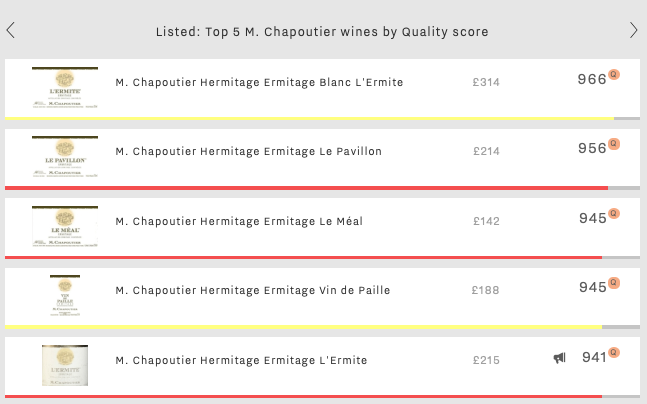
Next up is the first red of the group, Ermitage Le Pavillon, with a Quality score of 956. Wine Lister partner critic, Jancis Robinson, awards the 2016 vintage an impressive 19 points, naming it a “polished and pure Hermitage”. It also earns the group’s best Brand score of 897, appearing in 15% of the world’s best restaurants and ranking in 266th place for Wine-Searcher searches among the c.4,000+ wines on Wine Lister.
In joint-third place comes the second red of the group, Ermitage Le Méal, and Chapoutier’s sweet white, Ermitage Vin de Paille. Both achieve a Quality score of 945, however they are distinctive not just in their respective styles, but also in their Brand scores. Le Méal is clearly the better-known, with a Brand score of 724 and a search rank of 710, compared with the Vin de Paille’s Brand score of 593 (the lowest of this week’s top five), and a search rank of 2088. Interestingly however, the Vin de Paille’s presence in the world’s top restaurants is the better, if only by 1% (6% vs. 5% for Ermitage Le Méal).
Rounding out Chapoutier’s top five for Quality is the Ermitage L’Ermite, with a Quality score of 941. Despite its position at the bottom of the group, it achieves the highest Quality score at vintage level for the 2010 (992). The Ermitage L’Ermite 2010 achieves 95+ points from Wine Lister partner critic, Vinous, and though Josh Raynolds calls it “remarkably long, chewy, smoke- and spice-accented…”, he also warns it “should be stashed away and forgotten for a good long while”.
Château Latour has released a parcel of their 2008 this morning. It is being offered in the UK at c.£425 per bottle. The factsheet below summarises its key points.

You can download this slide here: Château Latour 2008
Wine Lister recently analysed the Bordeaux 2009 vintage in two parts. The first – a tasting and subsequent selection of top picks by Wine Lister’s founder, Ella Lister, revealed sublime quality across both banks. The second – a two-page analysis of the vintage overall – reveals that alongside top quality, prices of Bordeaux 2009s are high, and it is therefore all the more difficult to find good value, particularly among the left bank’s classified growths.
With this in mind, our Listed: top five blog this week explores the highest-quality Bordeaux fifth growths from the 2009 vintage. Despite the great quality across appellations, all five hail from Pauillac. They are all also Wine Lister Buzz Brands.
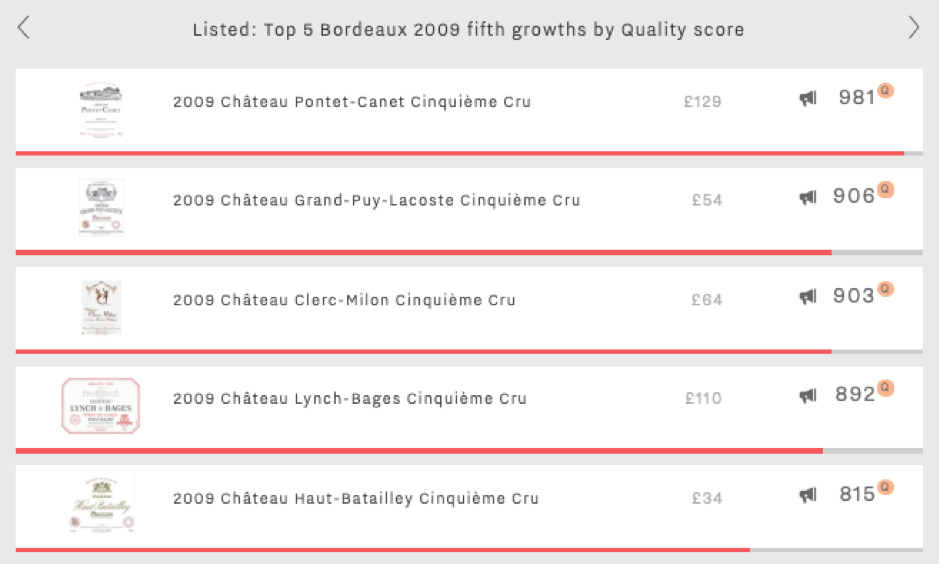
In first place is Pontet-Canet 2009. Its Quality score of 981 sits a full 102 points above the average of the other four wines in this week’s top five. This presumably contributes to its price of £129 per bottle in-bond – the highest of the group.
Next is Grand-Puy-Lacoste 2009, with a Quality score of 906 and the second-lowest price of this week’s top five (£54 per bottle in-bond). It is the only one of the group to appear among top picks from the recent 2009 re-tasting.
Just three points behind Grand-Puy-Lacoste, in third place, is Clerc-Milon 2009. In the economics department it outperforms the rest of the group significantly, with an Economics score of 905 and a compound annual growth rate (CAGR) of 17.3% – over two and a half times higher than the average of the other four wines in this week’s top five.
This week’s last two wines now fall under the same ownership, that of the Cazes Family. Nonetheless, the 2009 vintages of Lynch-Bages and Haut-Batailley, which achieve Quality scores of 892 and 815 respectively, present quite different profiles. Lynch-Bages is this week’s “brand king” with a Brand score of 996 – the highest of this week’s top five – and a price of £110 per bottle in-bond. Though Haut-Batailley 2009 achieves a Quality score 7% lower than Lynch-Bages, its price of £34 is 69% lower than that of its sibling, therefore providing exceptional value. After the acquisition and subsequent repositioning of Haut-Batailley through its 2017 en primeur release, it will be interesting to see how both châteaux fare in the upcoming 2018 campaign.
Wine Lister is experiencing a touch of Bordeaux fever. Having re-tasted Bordeaux 2016s in January, Wine Lister’s founder, Ella, attended BI Wines’ “10 years on” tasting last week, revisiting the iconic 2009 vintage.
As expected, the vintage yielded some truly exceptional wines, thanks to excellent weather conditions, especially around harvest time. However, some producers fell into the trap of waiting too long to pick, and high quality in 2009 is not a given. Ella has picked out 26 of the most successful examples of a unique and pleasure-giving vintage, hailing from across all of the best-known red wine Bordeaux appellations (N.B. no white wines were tasted).
The most heterogenous appellation was Saint-Emilion, with some wines rendered hot and hard by high alcohol, while those at the very top level were some of the best 2009s out there. Cheval Blanc, for example, achieved a “mystical, beguiling bouquet…like a magic potion”.
Pomerol did not seem to suffer from the heat in the same way, and made beautiful wines in 2009. Perhaps unsurprisingly, Le Pin garnered some exceptional comments, including “the richest, most decadent, abundant nose of the whole tasting”. Other Pomerol picks displayed an unusually dark-fruited character. Petrus (“not worn on the sleeve like the Le Pin”), had a “refined dark fruit character”, Hosanna “piercing damson fruit”, and La Conseillante boasted a “carnal, purple-fruit sweetness”.
On the left bank, Pessac-Léognan and Saint-Julien achieve joint-first place, earning five highlights each. Arguably the most impressive of these were La Mission Haut-Brion and Haut-Brion with the former described as “sensual, ethereal, and breath-taking”. Pape Clément showed almost “Rhône-esque animality”, while Malartic-Lagravière was “opulent” and “left you wanting more”.
Saint-Julien presented expected names – second growths Gruaud-Larose and Léoville Barton (described as “ultra-classical” and “thoroughbred” respectively), as well as a surprise in the form of Château Gloria, the only Cru Bourgeois to make it into this list of Bordeaux 2009 tasting highlights.
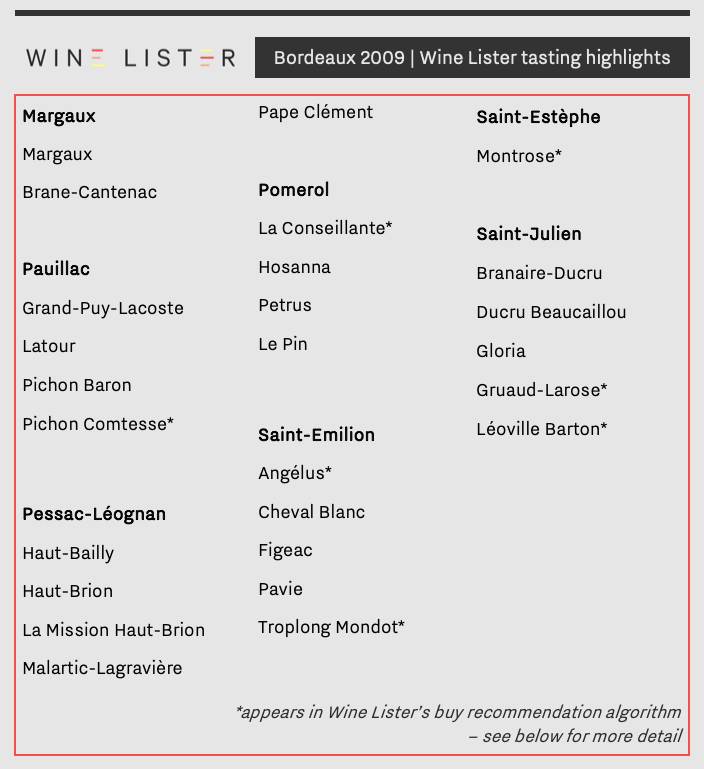
The remaining left bank appellations did not go wanting of favourites. Latour earned the comment, “impeccably turned-out, this wine demands attention”. Elsewhere in Pauillac Pichon Comtesse was “beguiling” and “gradually confident”.
In Margaux the appellation’s first growth namesake was hailed “quite the showstopper”, while Brane-Cantenac was “lifted, lovely, and luminous”. While Saint-Estèphe earned only one mention, its representative, Montrose surpassed expectation, appearing “supremely poised”.
All those wines marked “*” above currently qualify as Wine Lister “buy recommendations”. The Wine Lister team has been working hard to create a data-driven list of the ultimate best wines to buy – watch this space while we fine-tune the algorithm!
Other wines featuring in the Bordeaux 2009 highlights are: Grand-Puy-Lacoste, Pichon Baron, Haut-Bailly, Angélus, Figeac, Pavie, Troplong Mondot, Branaire-Ducru, and Ducru Beaucaillou.
Yesterday marked the annual BI Fine Wines’ 10 years on tasting, this year focusing on the iconic Bordeaux 2009s. Below we explore what light Wine Lister data has to shed on the 2009 vintage including quality, price performance, and best wines for good value.
Wine Lister’s holistic and dynamic approach allows us to not only see which appellations produced the vintage’s best wines, but also demonstrates if and how the market has since reacted to their relative quality.
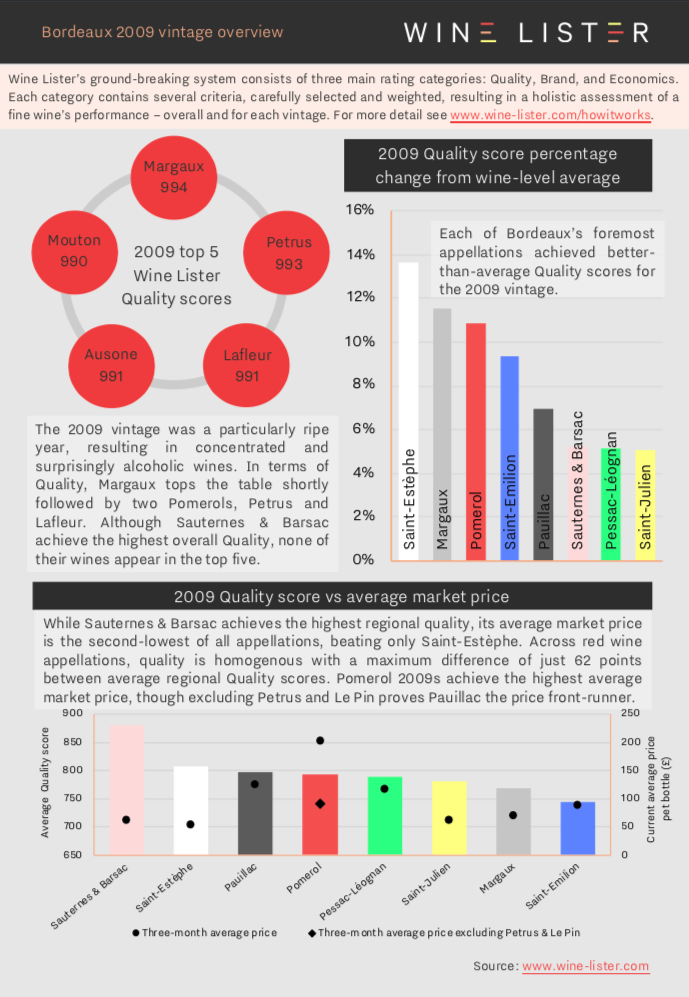

You can download the slides here: Wine Lister Bordeaux 2009 vintage overview
Featured wines: Margaux, Petrus, Lafleur, Ausone, Mouton, Capbern, Lilian Ladouys, Couhins-Lurton, Fourcas Hosten, Guillot Clauzel, Clos Saint-Martin, Lynsolence, La Cabanne, and Pavillon Rouge.
While the market for Bordeaux remains sturdy, and interest in Burgundy continues to grow, it is easy to overlook other traditional European fine wine regions despite their impressive quality and value for money, particularly compared with upward-spiralling Burgundian price tags. This week’s top five looks at such a region – the best of Spain’s iconic Rioja.
In first place is Bodegas Lopez de Heredia’s Rioja Gran Reserva with an overall Wine Lister score of 910. Though by no means the most expensive of the five (at £63 in-bond per bottle), it earns the highest Economics score of the group (926). This is down to impressive growth over both the short- and long-term, with a six-month price performance of 28.8% and a three-year compound annual growth rate (CAGR) of 36.2%.
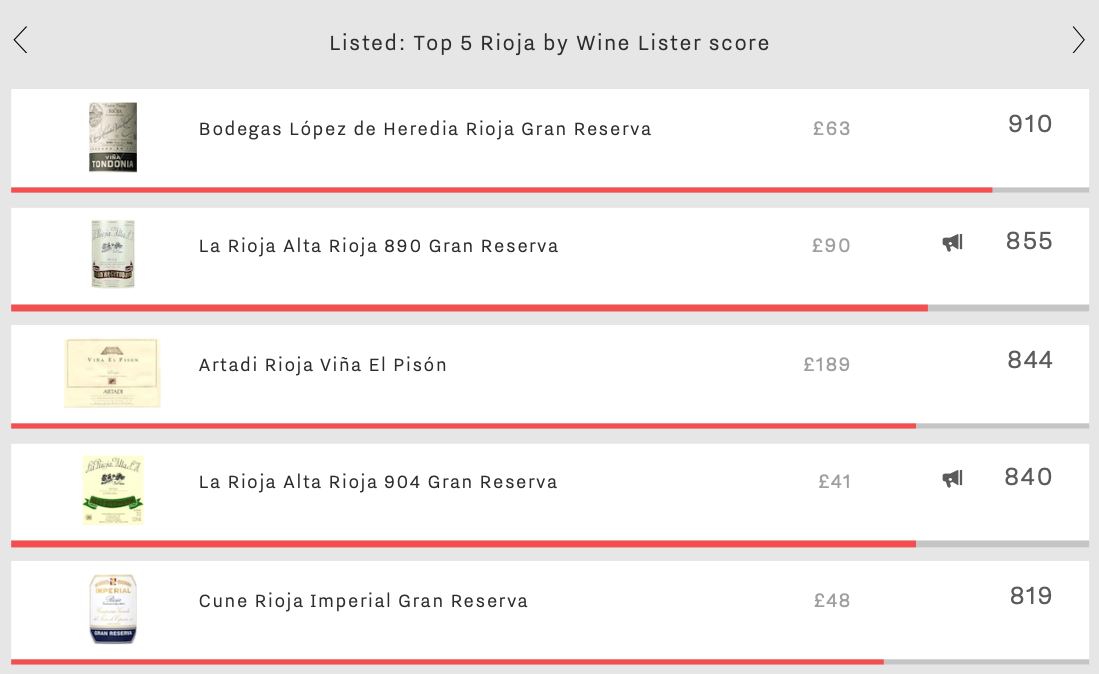
Next is the first of two wines in this week’s top five from La Rioja Alta, the 890 Gran Reserva with an overall score of 855. Its younger sibling, the 904 Gran Reserva earns fourth place in this week’s top five with a score of 840. Both wines are Buzz Brands, and while one costs more than twice as much as the other on average (£90 for 890 vs. £41 for 904), both sport similar brand successes, earning the top two spots for search rank in this week’s top five. La Rioja Alta’s 904 Gran Reserva is the 119thmost-searched-for wine of the 4,000+ wines on Wine Lister (the 890 is 284th), and earns the best Brand score of the group (902).
In third place of this week’s top five is a wine with a very different profile, not least as the only non-Gran Reserva of the group. Artadi’s Rioja Viña El Pisón achieves the lowest Brand score of the group, but the highest Quality score at 954. This combined with its low production rate of just 6,000 bottles per annum on average likely contributes towards it also having the highest price of this week’s top five, at £189 in-bond per bottle. In a global context, this price is still remarkably low for the Quality achieved – the nearest comparable Quality score for red Bordeaux is 953, achieved by Château Margaux at an average price of £422.
Finally, at number five is Cune Rioja Imperial Gran Reserva. Though middle of the range for almost every score criterion, Cune achieves the best vertical restaurant presence of the group, with an average of 1.6 vintages and/or formats in 10% of the world’s best restaurants.
Yesterday we examined Wine Lister founder, Ella Lister’s top left bank picks from the recent re-tasting of 204 Bordeaux 2016s, now in bottle.
Almost as many wines stood out across appellations on the right bank, from a tasting the following day of 171 wines – testament to the fantastic quality available across the board in 2016. There is no doubting 2016 is a great vintage in Bordeaux. Tasting these wines from bottle only served to confirm the Wine Lister team’s enthusiasm during en primeur tastings in the spring of 2017. Revisit our blog post from the time for details of the unusual weather conditions behind this vintage.
Wine Lister right bank highlights include 11 Saint-Emilion wines vs. 10 in Pomerol, and the top pick overall was Figeac, which was “intellectual”, “fine-boned” and “gourmand”.
Several of its well-known Saint-Emilion neighbours also made the cut into Wine Lister tasting highlights, including Canon ( “feather-light, but generous”), Clos Fourtet, and La Gaffelière.
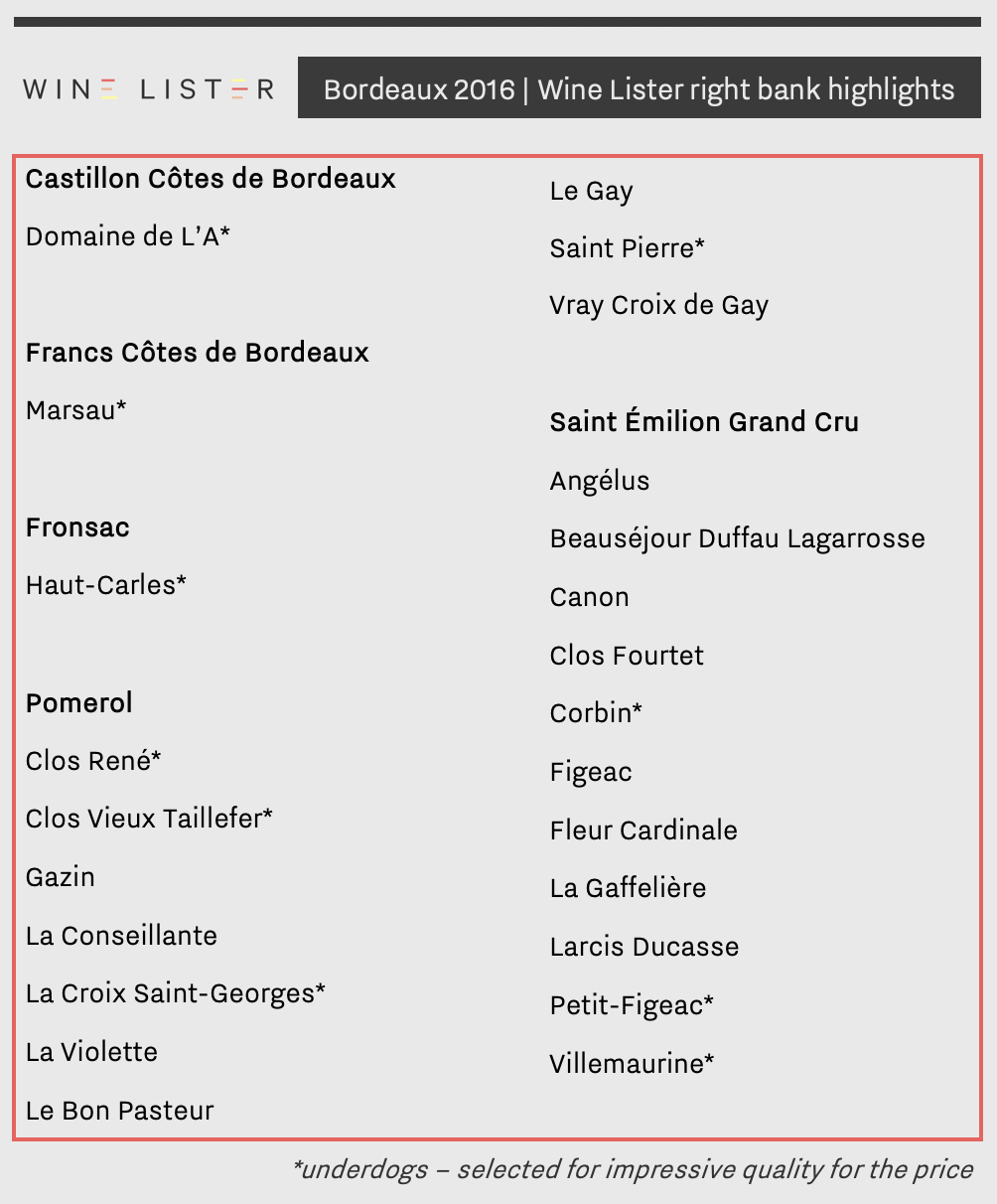 N.B. The tasting did not include wines such as Petrus, Le Pin, Vieux Château Certan, Trotanoy, Ausone, Cheval Blanc, or Pavie.
N.B. The tasting did not include wines such as Petrus, Le Pin, Vieux Château Certan, Trotanoy, Ausone, Cheval Blanc, or Pavie.
However, it was Pomerol that produced more “underdogs” than its neighbour: not-so-big names punching above their weight. Of particular note were Clos Vieux Taillefer and La Croix Saint-Georges.
Among Pomerol top dogs, La Violette was showing beautifully, with a “delicate, fresh” nose and “unctuous, satin” palate. Vray Croix de Gay was “refined” and “thoroughbred”, while La Conseillante produced a “gorgeous, fine-grained texture”.
Further afield, Domaine de l’A from the Côtes de Castillon impressed, as did Marsau, from Francs Côtes de Bordeaux.
Also included in Bordeaux 2016 right bank picks were: Gazin, Saint Pierre, Le Gay, Beauséjour Heritiers Duffau Lagarrosse, Larcis Ducasse, Angélus, Villemaurine, Fleur Cardinale, Clos René, Corbin, and Petit Figeac.
Last week Wine Lister shared top picks from Burgundy 2017 tastings. This week the focus is Bordeaux, after Wine Lister’s founder, Ella Lister, re-tasted through the 2016 vintage with Wine Lister partner critics Michel Bettane and Thierry Desseauve, thanks to négociants Joanne and CVBG.
We are in the process of updating Wine Lister Quality scores based on new, in-bottle scores from Wine Lister partner critics Bettane+Desseauve, Antonio Galloni, and Neal Martin, and in the meantime we share Ella’s left bank picks below.
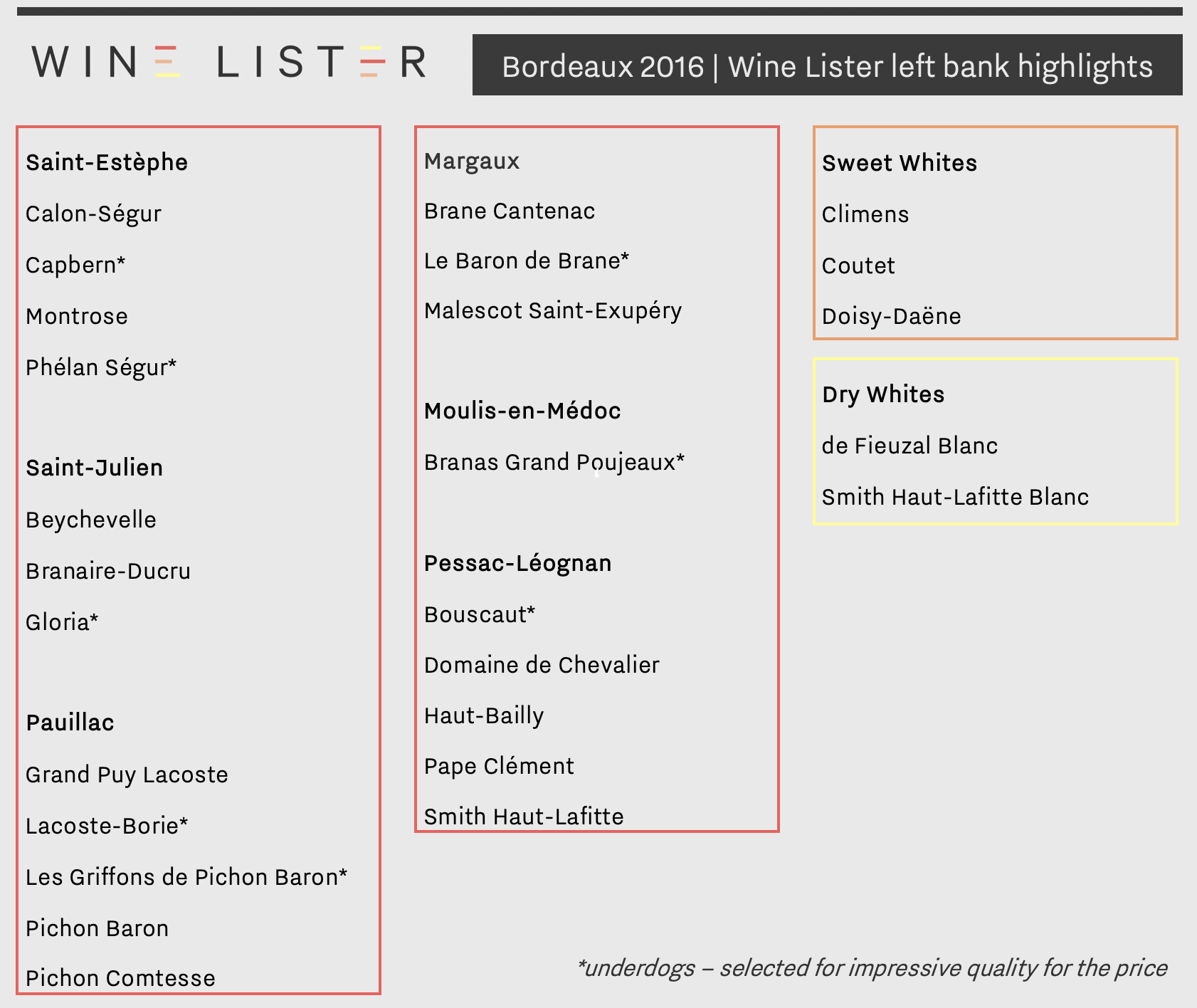 N.B. The tasting did not include first growths, or wines such as Cos d’Estournel, Palmer, Léoville Las Cases, Ducru Beaucaillou, and Pontet-Canet.
N.B. The tasting did not include first growths, or wines such as Cos d’Estournel, Palmer, Léoville Las Cases, Ducru Beaucaillou, and Pontet-Canet.
The spread of favourites from across left bank appellations reflects the homogeneity of the 2016 vintage overall.
Saint-Estèphe was a standout appellation in 2016. Two top dogs, Calon-Ségur and Montrose earned significant praise – Calon is described as having “ballet slipper poise” and a “core of energetic fruit”, where Montrose appeared “elegant, silky and delectable”, with a much-improved integration of oak than the en primeur sample. Beside these sit two underdogs, Capbern and Phélan Ségur, which punch above their expected qualitative weight.
Saint-Julien earns three picks, with Beychevelle being a particular highlight, hailed “ravishing, with vitality and a satin finish”. In Pauillac, Pichon Baron and Pichon Comtesse were both notable, with the former appearing “refined, aristocratic and accomplished”, the latter “exciting, racy, and moreish”. Both Brane-Cantenac and Malescot Saint-Exupéry brought signature Margaux elegance to the tasting mix.
Pessac-Léognan reds were showing particularly well, earning an equal number of highlights as powerhouse Pauillac overall. Haut Bailly made the cut alongside Domaine de Chevalier, Pape Clément and Smith Haut-Lafitte. Bouscaut stood out as the underdog of the Graves.
A few further surprises arose across red appellations, including Gloria, Lacoste-Borie (the second wine of Grand-Puy-Lacoste), and Branas Grand Poujeaux.
Less surprising was the high quality of sweet staples, Climens, Doisy Daëne, and Coutet. Of dry whites, the stand-outs were Smith Haut-Lafitte Blanc (labelled “tonally a step above”), and de Fieuzal Blanc.
Other wines featured in the Bordeaux 2016 left bank highlights are: Branaire-Ducru, Le Baron de Brane, and Les Griffons de Pichon Baron.
One of the major trends identified in Wine Lister’s first Champagne study was the rise of grower Champagnes. While maison offerings dominate the top 20 highest-quality Champagnes from the basket of 108 studied, growers achieve a higher average Quality score overall (862 vs. 853). This week’s top five looks at the top Champagnes under £100 by Quality score, and helps us examine the grower vs. maison phenomenon further.
The first of this week’s top five is grower Champagne Egly-Ouriet’s Vieillissement Prolongé Extra Brut with a Quality score of 919. Though top of the leader board for Quality, it is the least expensive of this week’s group at an in-bond per bottle price of £55 (or 34% less than the average price of the other four Champagnes). This is perhaps due to it being the only non-vintage Champagne of the group, and provides testament to the great price to quality ratio of N.V. Champagnes across the board.
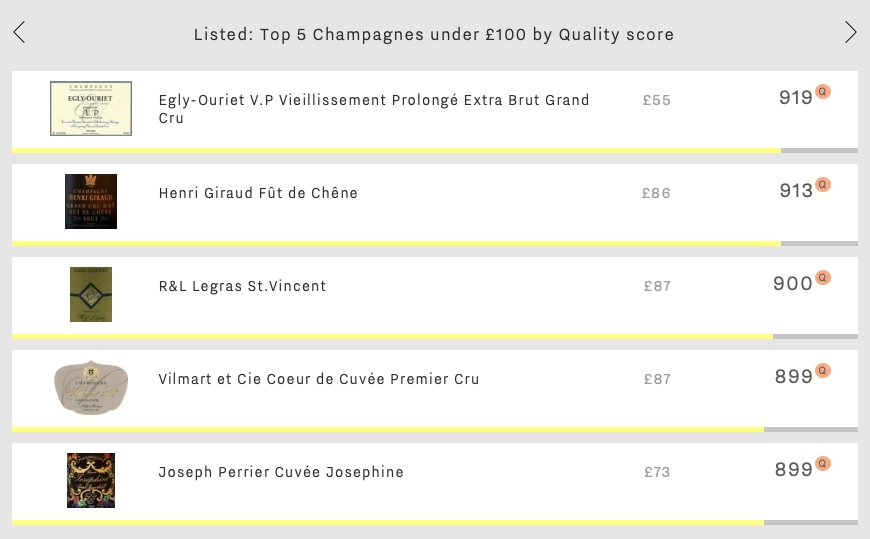
Next up of this week’s top five is Henri Giraud’s Fût de Chene with a Quality score of 913. For the purposes of Wine Lister’s Champagne study, Henri Giraud was in fact not classed as a grower Champagne, since our definition of ‘grower’ signified properties who use 100% of their own grapes (Henri Giraud buys in 20%). The 1999 vintage earns 18 points from Wine Lister partner critic Jancis Robinson, who calls it “a sort of Montrachet of Champagne”.
Third of this week’s top five is R&L Legras’ St. Vincent. Earning a Quality score of 900, it is the only Blanc de Blancs of the group. In true grower fashion, this little-known Champagne ranks as the 1,985th most-searched-for wine of the c.4,000+ wines on Wine Lister and is present in just 3% of the world’s best restaurants.
The last two Champagnes of this week’s top five may have the same Quality score of 899, but have very different profiles. It is surely a satisfying conclusion that, despite maison Champagne’s stronger brand position overall, these two wines (one maison and one grower) prove the opposite to be true. Maison offering Joseph Perrier’s Cuvée Josephine has the lowest Brand score (474) of this week’s top five, while grower Champagne Vilmart et Cie Coeur de Cuvée earns the highest (779), with a search rank in 854th place and presence in 11% of the world’s best restaurants. The rise of grower Champagnes is in full force.
For a more in-depth look at Champagne, subscribe or log-into read the full report here. Alternatively, all readers can access a five-page executive summary. (Both versions are also available to download in French).
 Happy with their 2018s: Guillaume Pouthier, Pierre-Olivier Clouet, and Nicolas Glumineau
Happy with their 2018s: Guillaume Pouthier, Pierre-Olivier Clouet, and Nicolas Glumineau






 N.B. The tasting did not include wines such as Petrus, Le Pin, Vieux Château Certan, Trotanoy, Ausone, Cheval Blanc, or Pavie.
N.B. The tasting did not include wines such as Petrus, Le Pin, Vieux Château Certan, Trotanoy, Ausone, Cheval Blanc, or Pavie. N.B. The tasting did not include first growths, or wines such as Cos d’Estournel, Palmer, Léoville Las Cases, Ducru Beaucaillou, and Pontet-Canet.
N.B. The tasting did not include first growths, or wines such as Cos d’Estournel, Palmer, Léoville Las Cases, Ducru Beaucaillou, and Pontet-Canet.